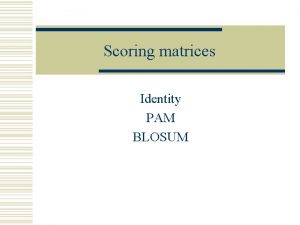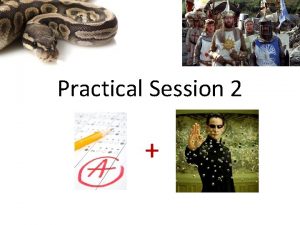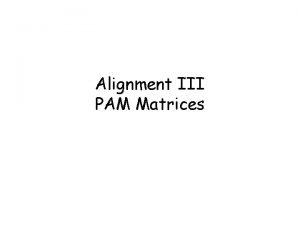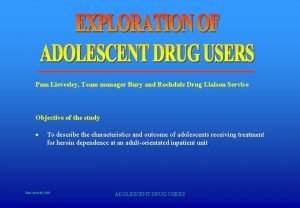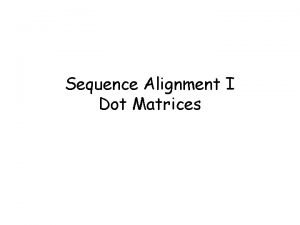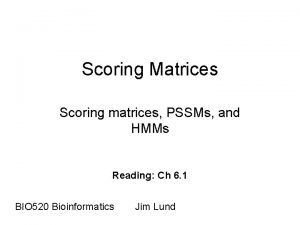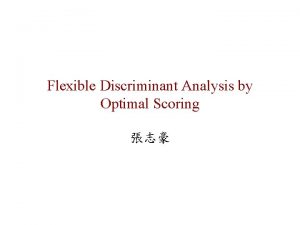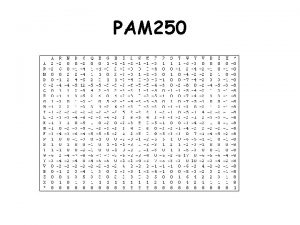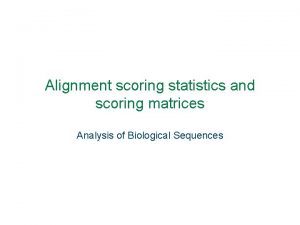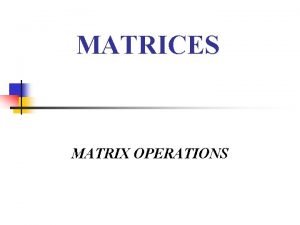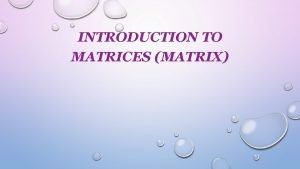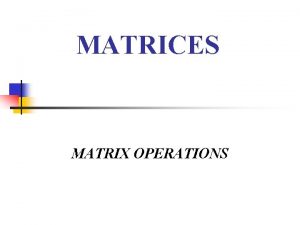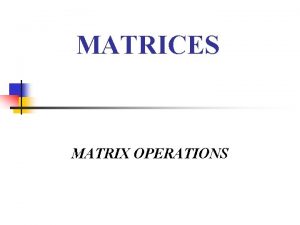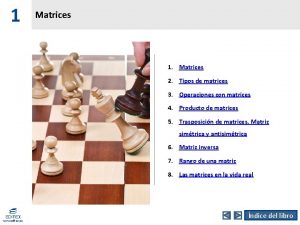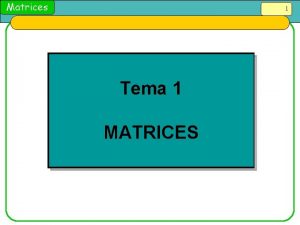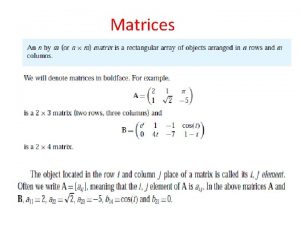Alignment III PAM Matrices PAM 250 scoring matrix


![Scoring Matrices S = [sij] gives score of aligning character i with character j Scoring Matrices S = [sij] gives score of aligning character i with character j](https://slidetodoc.com/presentation_image/358d019f89a801d9d75f02636e4c6d85/image-3.jpg)













- Slides: 16

Alignment III PAM Matrices

PAM 250 scoring matrix 2
![Scoring Matrices S sij gives score of aligning character i with character j Scoring Matrices S = [sij] gives score of aligning character i with character j](https://slidetodoc.com/presentation_image/358d019f89a801d9d75f02636e4c6d85/image-3.jpg)
Scoring Matrices S = [sij] gives score of aligning character i with character j for every pair i, j. C 12 S 0 T -2 1 3 P -3 1 0 6 A -2 1 1 1 2 C T P A STPP CTCA 2 S 0 + 3 + (-3) + 1 =1 3

Scoring with a matrix • Optimum alignment (global, local, endgap free, etc. ) can be found using dynamic programming – No new ideas are needed • Scoring matrices can be used for any kind of sequence (DNA or amino acid) 4

Types of matrices • • • PAM BLOSUM Gonnet JTT DNA matrices PAM, Gonnet, JTT, and DNA PAM matrices are based on an explicit evolutionary model; BLOSUM matrices are based on an implicit model 5

PAM matrices are based on a simple evolutionary model GAATC GAGTT Ancestral GA(A/G)T(C/T) sequence? Two changes • Only mutations are allowed • Sites evolve independently 6

Log-odds scoring • • • What are the odds that this alignment is meaningful? X 1 X 2 X 3 Xn Y 1 Y 2 Y 3 Yn Random model: We’re observing a chance event. The probability is where p. X is the frequency of X Alternative: The two sequences derive from a common ancestor. The probability is where q. XY is the joint probability that X and Y evolved from the same ancestor. 7

Log-odds scoring • Odds ratio: • Log-odds ratio (score): where is the score for X, Y. The s(X, Y)’s define a scoring matrix 8

PAM matrices: Assumptions • Only mutations are allowed • Sites evolve independently • Evolution at each site occurs according to a simple (“first-order”) Markov process – Next mutation depends only on current state and is independent of previous mutations • Mutation probabilities are given by a substitution matrix M = [m. XY], where mxy = Prob(X Y mutation) = Prob(Y|X) 9

PAM substitution matrices and PAM scoring matrices • Recall that • Probability that X and Y are related by evolution: q. XY = Prob(X) Prob(Y|X) = px m. XY • Therefore: 10

Mutation probabilities depend on evolutionary distance • Suppose M corresponds to one unit of evolutionary time. • Let f be a frequency vector (fi = frequency of a. a. i in sequence). Then – M f = frequency vector after one unit of evolution. – If we start with just amino acid i (a probability vector with a 1 in position i and 0 s in all others) column i of M is the probability vector after one unit of evolution. – After k units of evolution, expected frequencies are given by Mk f. 11

PAM matrices • Percent Accepted Mutation: Unit of evolutionary change for protein sequences [Dayhoff 78]. • A PAM unit is the amount of evolution that will on average change 1% of the amino acids within a protein sequence. 12

PAM matrices • Let M be a PAM 1 matrix. Then, • Reason: Mii’s are the probabilities that a given amino acid does not change, so (1 Mii) is the probability of mutating away from i. 13

The PAM Family Define a family of substitution matrices — PAM 1, PAM 2, etc. — where PAM n is used to compare sequences at distance n PAM n = (PAM 1)n Do not confuse with scoring matrices! Scoring matrices are derived from PAM matrices to yield log-odds scores. 14

Generating PAM matrices • Idea: Find amino acids substitution statistics by comparing evolutionarily close sequences that are highly similar – Easier than for distant sequences, since only few insertions and deletions took place. • Computing PAM 1 (Dayhoff’s approach): – Start with highly similar aligned sequences, with known evolutionary trees (71 trees total). – Collect substitution statistics (1572 exchanges total). – Let mij = observed frequency (= estimated probability) of amino acid Ai mutating into amino acid Aj during one PAM unit – Result: a 20× 20 real matrix where columns add up to 1. 15

Dayhoff’s PAM matrix All entries 104 16
 Difference between blosum and pam
Difference between blosum and pam Amino acid substitution matrix
Amino acid substitution matrix Gonnet pam 250 matrix
Gonnet pam 250 matrix Global alignment vs local alignment
Global alignment vs local alignment Pam1250
Pam1250 Global alignment vs local alignment
Global alignment vs local alignment Global and local alignment
Global and local alignment Global alignment example
Global alignment example Bury pam pam
Bury pam pam What are role scoring and script scoring
What are role scoring and script scoring Brigance screen
Brigance screen Hamlet act iii scene ii
Hamlet act iii scene ii Dot matrix alignment
Dot matrix alignment Pam matrix sap
Pam matrix sap Pssms
Pssms Linear discriminant analysis example
Linear discriminant analysis example Considerate constructors scoring matrix
Considerate constructors scoring matrix
